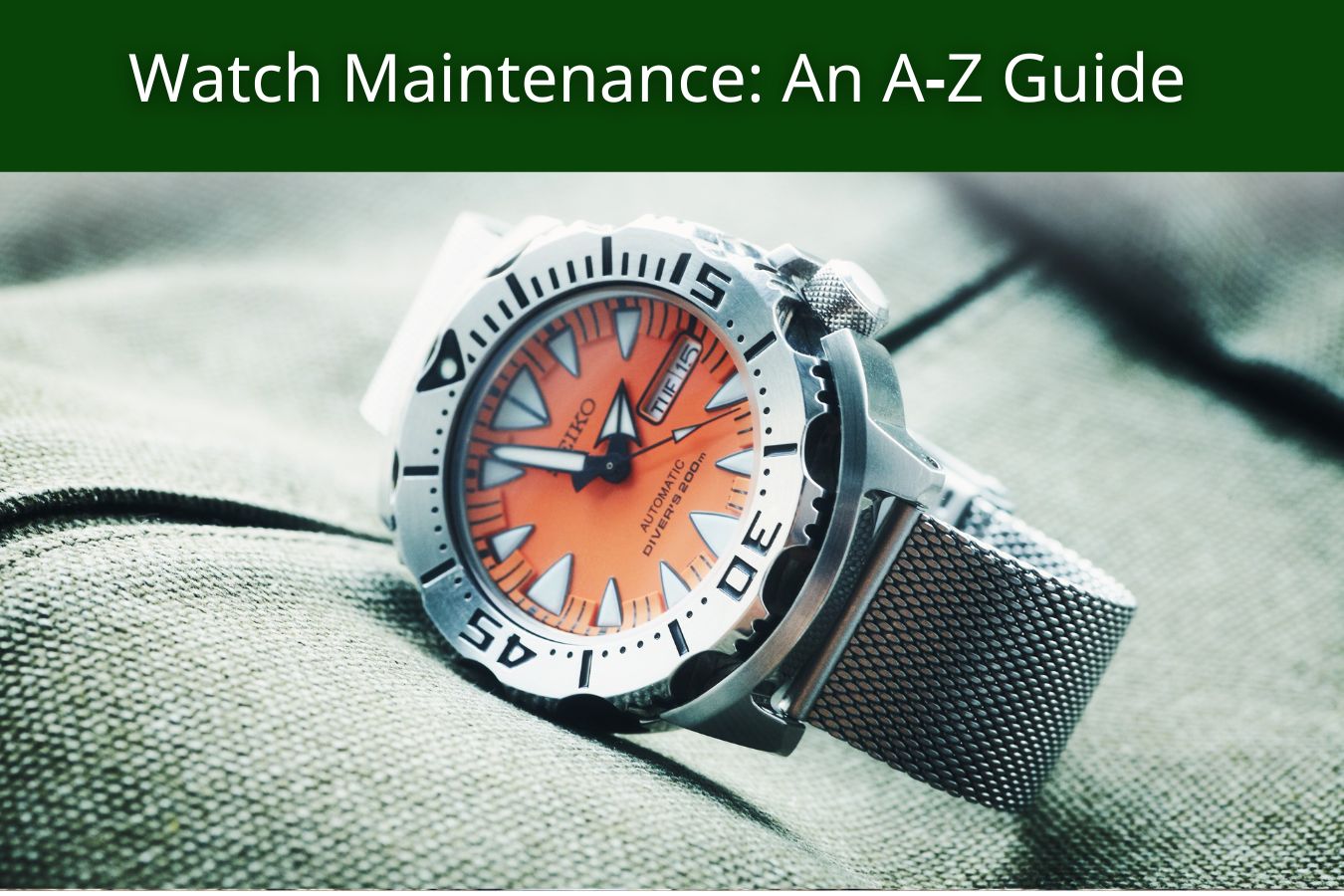So, how do you maintain your watch? Depending upon the nature of your watch, there could be a lot of points to consider in order to maintain your watch. General dos and don’ts of maintaining a watch include proper winding for mechanical watches, regular cleaning, and avoiding shocks. Other factors like keeping your watch away from magnets and other electronics are also included in the package.
For watch collectors, maintaining a watch for a lifetime is a very big achievement. This is easily possible. You just have to be a little mindful. In this post, we will learn everything you need to know to become a good caretaker of your watch.
Maintenance of Different Types of Watches
The first step toward maintaining your watch is understanding its type. There are mainly three types of watches in the market, depending upon their functionality. In this post, we will thoroughly discuss the main differences and the special care requirements of each type of watch.
Mechanical Watch
A mechanical watch is a watch that uses wheels, levers, or other mechanisms to tell the time. They are also known as “watches with a movement” or “watches with a spring.” The word “mechanical” means that these watches do not have any batteries or electronics inside of them.
Mechanical watches have been around since the 1600’s, when they were first invented by Swiss watchmakers. These watches use gears, springs, and escapements to keep time. This type of watch is still popular today because of its classic look and the fact that it can last for many years if you take care of it properly.
Maintaining A Mechanical Watch
Mechanical is a true classic. They are still being produced because of their state-of-the-art mechanisms. The science behind these watches is pretty simple yet very precise. Are you a proud mechanical watch owner? Follow the guidelines below to maintain your timeless timepiece:
Winding Your Watch
First things first, properly winding the main spring is the most important thing to look at in a mechanical watch. The first step in winding a mechanical watch is to remove the crown, which is usually screwed into the case. To do this, turn the crown counterclockwise until it clicks into place.
To start winding the watch, hold it upright with the crown facing down and gently pull out on it until you feel resistance. Then, hold your other hand over the crown and press down with your fingers while pulling out on it again. Continue doing this until you feel more resistance than before when pulling out on the crown. This may take several minutes to get right, so be patient! If you find that you’re getting too much resistance when winding your watch, try reversing directions or using another method of winding, such as a screwdriver which can help make sure that everything lines up correctly before starting to wind your timepiece.
When winding your watch, always keep both hands on top of each other and never let them separate from each other during this process. Also, make sure that when winding up one side of the movement, you do not allow any part of your hand or wrist to touch.
Regular Cleaning Of Watch
Wearing a mechanical watch is an art. It’s not just about telling time but also about looking good and keeping your watch running smoothly. If you have a mechanical watch, you’ll want to take care of it by regularly cleaning the case and bracelet. Here’s how:
1) Remove all jewelry from your wrist. If you’re wearing a bracelet or other wrist accessory, remove it before cleaning the watch. This is to avoid any further scratches or dents on your watch.
2) Use an old toothbrush or soft cloth with some mild soap to clean any dirt off the face of your watch. Additionally, use a cotton swab dipped in fingernail polish remover to gently remove any hard-to-reach spots.
3) Use a soft toothbrush to gently scrub away any remaining dirt or grime from between each gear tooth in the movement (the mechanism inside). This is important because this space collects gunk over time, which can cause friction and reduce the accuracy of your watch. So, your best bet is to keep it clean!
Follow these steps regularly, and you won’t have to take your watch to the watch repairer ever.
Periodic Servicing
The next habit that makes a mechanical watch last forever is not missing the periodic service. After every three to five years, you should lubricate your watch’s mechanical parts. If you believe that you are not very good at DIYing, you can take your prized possession to a professional.
Taking to a professional watch repairer is also a good idea because in this way you can be aware of any faults. Moreover, you will also have the option to get the part replaced right away.
Automatic Watch
An automatic wristwatch is a type of watch that uses the motion of your wrist to wind the mainspring, which powers the watch. Automatic watches are considered more accurate and have a longer power reserve than most quartz watches. They are also more expensive and require more maintenance. Unlike mechanical watches, which require mechanical winding to run, an automatic watch is powered by the kinetic energy of your body.
The first automatic watches were invented in the 18th century, but they didn’t gain popularity until the 1970s. While they are no longer the most popular type of watch, they remain beloved by many for their classic style and superior craftsmanship.
Maintaining an Automatic Watch
Earlier in this post, we learned how to maintain a mechanical watch over time. Now, we will learn about maintaining an automatic watch which is more complex than the former ones.
Here are the tips that you should follow to keep your timepiece in pristine condition:
Wearing is Caring
Automatic watches are a popular choice for those who want the convenience of not having to wind their watch regularly. However, automatic watches do need some care and maintenance to keep them running smoothly. One of the best ways to care for an automatic watch is to simply wear it regularly.
By keeping the watch in motion, you help to keep the mechanical parts in the movement calibrated, which helps to prevent wear and tear. If you don’t wear your watch for extended periods of time, you may find that the battery needs to be replaced more often. So if you want to keep your automatic watch in good condition, make sure to wear it often.
What happens if you are unable to wear your automatic watch for a while? Your watch stops working, and then you will have to manually wind it, which can affect the accuracy.
General Cleaning
Cleaning your automatic watch plays a very important role in expanding its lifespan. However, if you don’t have experience and extensive knowledge of cleaning an automatic watch, there are chances of accidentally damaging the watch.
Down below is a step-by-step guide on how to clean an automatic watch properly:
- Take tissue paper or a piece of cloth and dip it in mild soapy water.
- Remove the dial from the straps.
- Gently clean the dial using a piece of cloth or tissue paper.
- For metal straps, use a soft brush and spray some metal shinner on them.
- Very carefully, use the brush to reach places where you can’t reach using a tissue.
- In the case of leather straps, wash them using soft soapy water.
- Apply some leather treatment products to it after washing.
- Let the strap and dial dry separately at room temperature.
Yes! It is that simple. Almost every good quality watch and the metal strap is made with stainless steel nowadays. So, short contact with water won’t be an issue for your watch.
Servicing
Just like mechanical watches, automatic wristwatches also require periodic servicing to stay in their best shape. Servicing is mainly important for the internal mechanical components of your watch.
Periodic servicing includes cleaning and oiling the moving parts of your watch. Why is it necessary? Because time, dirt, and grim slow downs the movement of your watch. In order to maintain its accuracy, you have to service it or take it to a professional for servicing.
Quartz Watches
Quartz watches are a type of battery-powered timepiece that uses an electronic oscillator synchronized by a quartz crystal to keep time. This crystal oscillates at a very precise frequency, which is used to keep time.
Quartz watches are some of the most accurate watches available, and they are also relatively inexpensive to manufacture. Because of these qualities, quartz watches are among the most popular types of watches on the market today. In addition to being accurate and affordable, quartz watches are also low-maintenance, meaning that they do not require frequent servicing or adjustment.
For all these reasons, quartz watches make an excellent choice for anyone looking for a dependable and stylish timepiece.
Maintaining A Quartz Watch
The maintenance of a quartz watch is slightly different from the mechanical and automatic watches. As mentioned above, instead of the mainspring, Quartz watches run on battery. If you have recently spent your savings on a quartz watch, here are the tips to keep it in immaculate condition for years:
On-Time Battery Replacement
This is the most important point related to the care of quartz watches. Good quality quartz watches come with premium batteries that last for years. However, all kinds of batteries are prone to leakage. Therefore, the best rule of thumb is to replace the batteries of your watch after every two years, even if they are working perfectly fine.
No matter if your watch is made up of stainless steel or not, battery leakage can completely destroy your timepiece. If it is sitting in the box for a long time, make sure the batteries are out.
General Cleaning
The general cleaning of quartz watches is similar to mechanical and automatic watches. Simply follow the steps mentioned above for an automatic watch, and you are good to go. One thing to note here is that don’t submerge your watch directly into the water, even if it’s water-resistant.
How do I know if my watch needs service?
There are multiple ways of detecting if your watch is in need of service or not. Some points that indicate the need of servicing your watch are:
- In most cases, the watch slowdowns when it requires servicing. In some instances, it can become fast as well.
- If you see moisture from the inside of your watch’s glass, then this is not a good indication. This shows that the seals of your watch have been compromised and need servicing.
- If the handle or crown of your watch starts feeling too loose or tight, this is another indication that your watch needs servicing.
FAQs
Professionally, watches, just like other pieces of valuable jewelry, are cleaned using ultrasonic cleaners. In this process, the dirt particles on your watch are removed using high-frequency sound waves and some chemicals. Bubbles stick to the dirt particles on your timepiece and are carried away by soundwaves.
Water resistance doesn’t mean waterproofing at all. If your watch says that it is water resistant, it means that it can bear water pressure up to some extent. However, if your watch is in continuous contact with water, then it will be damaged if it isn’t specifically made for the purpose.
Watch Maintenance in a Nutshell
In this guide, we all learned about different types of watches and how we can maintain them to accompany us for life. There are three main types of wristwatches, and each one of them has specific needs. In today’s post, we learned how to maintain all three types of watches and enjoy them for life.




